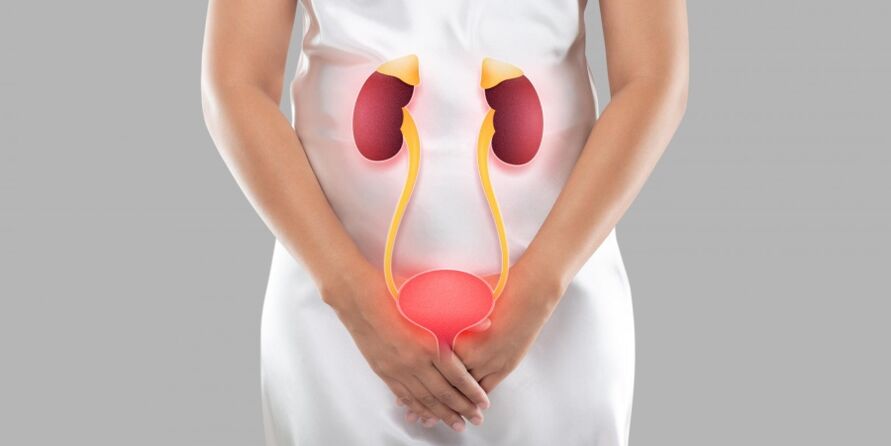
What is female cystitis
- Adhesions form in MP.
- Urinary system dysfunction.
- Renal Failure.
- Bleeding and ulceration of the bladder wall.
- Benign and malignant tumors.
Reason for occurrence
- Infections, including those spread through unprotected sex. In this case, the entry of pathogenic microorganisms is ascendant. They first enter the vagina and urethra.
- Special operations and surgeries. For example, long-term bladder catheterization significantly increases the likelihood of inflammatory processes.
- Certain cleansers and care products used for intimate hygiene contain substances that may cause an aggressive reaction in the body.
- Exposure to low temperatures due to reduced immunity. It is worth understanding that mere exposure to cold does not cause pathology. This stay can lead to cystitis in immunocompromised women.
- Chronic infection of any site.
- Recently suffered from inflammatory gynecological disease.
- Disorders of the hormonal system.
- Failure to follow personal hygiene rules.
- A chaotic intimate life.
- obesity.
- Long-term use of certain drugs can reduce the body's protective capabilities.
- Other conditions, including diabetes, and the presence of chronic infections in the body.
Symptoms of cystitis in women
- A feeling of discomfort and swelling in the area where the MP is located.
- Feeling the urge to urinate more often than usual, regardless of the amount of fluid consumed.
- Lower abdominal pain.
- Impaired urinary outflow, manifested by less urine being excreted and a persistent feeling of fullness in the bladder.
- The urine changes color to brown or reddish and smells different than normal.
- An unpleasant sensation occurs during emptying the bladder, manifested by pain and burning.
- Bloating.
- False urge to defecate.
- Displaces pain to other areas of the pelvis.
- Urine is turbid due to inclusions of blood or mucus.
- sleep disorder.
Diagnosis of cystitis
- Urine is collected for analysis of its cellular and biological components. It is important to explain to the patient the basic rules for preparing and directly collecting urine.
- General venous blood tests. Its purpose is to check for the presence of other diseases and assess the general condition.
- Urine bacterial culture, which allows you to isolate pathogens using special culture media. In addition, the technology aims to determine the sensitivity of microorganisms to certain drugs, which makes it possible to select effective drugs for the treatment of cystitis in women.
- Cystoscopy involves inserting a thin tube with a camera on the end through the urethra to examine the bladder mucosa. The picture is displayed on a monitor and the doctor has the opportunity to assess the condition of the tissue. Tissue samples can be collected for further histological examination.
- Ultrasound examination of the kidneys and bladder.
Treatment of cystitis
antibiotic
diuretics
Antispasmodics
vitamin preparations
- Help enhance local immunity;
- Stimulates bladder function;
- Accelerates the tissue regeneration process.
- Multivitamins containing at least two ingredients.
- Vitamin complex for cystitis in women. Contains useful elements and minerals. Promotes recovery and overall strengthening of the body.
- Single vitamins are used in the treatment of severe immune deficiencies and chronic diseases characterized by frequent exacerbations.
Dietary characteristics of cystitis
- Contains no spices, marinades, bacon and pickles. You should also avoid sweets and fried foods. You should strive to reduce your salt intake as much as possible. Alcohol and carbonated drinks, as well as tea and coffee, should be prohibited.
- Reduce consumption of fish, poultry and fatty meats.
- Minimize consumption of dairy and fermented dairy products. Unsalted low-fat cheese, low-fat yogurt and cottage cheese are allowed, along with small amounts of milk.
- Increase the proportion of fresh fruits and vegetables as well as vegetable oils, grains and bran in your daily diet.
cystitis in pregnant women
- Do not proactively take antibiotics to eliminate a problem unless prescribed by your doctor. This is because taking antibacterial drugs can have negative effects on the fetus, and only qualified experts know which drugs are safe during pregnancy.
- Avoid drips, which involve injecting liquid medication into the urethra and bladder. Masturbation is dangerous for pregnant women as it can lead to miscarriage in early pregnancy.
- Avoid taking non-steroidal medications with anti-inflammatory properties, which may cause lesions in children.
- Do not undergo physical therapy.
- Minimize the number of hot baths you take, and avoid saunas, bathtubs, and steam rooms to avoid overheating, which can lead to uterine muscle hypertonia.
prevention
- Avoid hypothermia.
- Make sure your bladder is empty on the first impulse.
- Maintain a healthy intimate life and avoid promiscuity and unprotected relationships.
- Drink enough clean drinking water every day.
- Treat any infection of the genitourinary system promptly.
- Follow personal hygiene rules.
FAQ
Do you have chronic cystitis?
- Primary, characterized by initial inflammation of the bladder.
- Second, the inflammatory process first appears in nearby organs and then spreads to the MP.
What harm does cystitis cause to women?
What infections can cause cystitis in women?
Reasons for Frequent Occurrence of Cystitis
- Promiscuity.
- Taking antibiotics that can negatively impact the vaginal and intestinal microbiota.
- Change partners frequently.
- People who use spermicides for contraception.
- Postmenopausal.
- Remaining urine after urination, which is caused by genital prolapse.
- Estrogen levels decrease.
- The positional characteristics of the urethra result from anatomic abnormalities.
Can cystitis cause urinary incontinence?
Can cystitis cause constipation?
What can a guardian do for cystitis?
- Apply dry heat to the lower abdomen.
- Antispasmodics are allowed during breastfeeding.
























